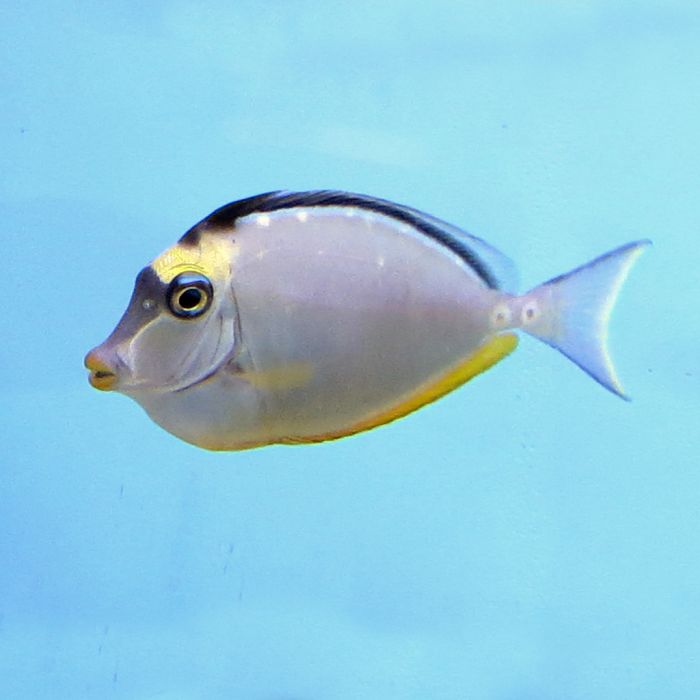Naso Tang (Asia Pacific)
The Naso tang is a common import from the Philippines and Bali. It has an elongated, tear-drop shaped body which is primarily a soft, mousy grey. As a juvenile it may show small white blotches on its flank. Its face slopes gently towards its snout, giving it the common name smooth head unicorn. Above its eye the skin shines blue, and it has a distinctive mask of yellow over its face which extends down towards its orange lips. It has two scalpels near the tail, colored a bright orange. The lower fins are also orange, and its dorsal fin is dark black which makes a striking contrast against the rest of the fish. Its tail is pointed at the tips, and on a mature male these tips may extend to long streamers. The streamers may begin to grow when the fish is 5-6 inches, until then males and females are visually identical.
The Naso tang can grow to be approximately 18 inches long and needs a large aquarium as an adult, we recommend at least 250 gallons or larger.
Naso tangs tend to grow on the larger side, so they need lots of space to swim. Because of their large size they are quite strong, and may be able to graze some macroalgaes such as sargassum. They don't appreciate living with tangs sharing the same shape, however are typically non-aggressive with other fish.
Tangs are also called surgeonfish or doctor fish because they have at least one spine just in front of the tail which, when the tail is bent, can be stuck out and used as a threat display or weapon against competitive fish or predators. It is important to be cautious of this spine when handling the fish in a net. They feel most secure when there is plenty of live rock to hide in, as well as open space for swimming. In the wild some tangs live in schools, however in the confines of an aquarium it is usually best to have only one of each genus, or they may be extremely aggressive to each other. They are typically very peaceful with other types of fish.
Care should be taken with tangs to ensure they do not catch external parasites, such as Marine ICH and velvet, to which they are very prone.
Tangs do not eat coral or invertebrates and are considered reef safe. They are primarily herbivorous, and although they love to eat meaty foods, they must be fed plenty of marine algae in order to remain healthy and vigorous. Having a proper diet may also reduce aggressive behaviors; tangs naturally graze on algae throughout the day. Diet should include plenty of marine algae and Spirulina, frozen mysis shrimp, and other high quality items. They typically learn to eat dry foods easily. It is preferable to feed more than once a day, with an algae clip offered approximately every other day.
Customers who bought this also purchased
 Foxface (Asia Pacific)Out of stock
Foxface (Asia Pacific)Out of stock
















